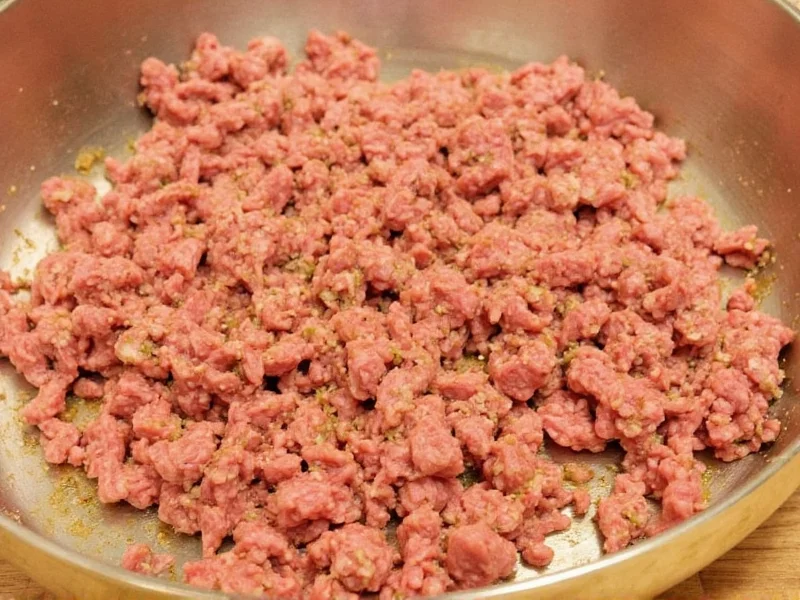The best way to season ground beef for pasta involves adding salt early during browning, incorporating dried herbs like oregano and basil when the meat is halfway cooked, and finishing with fresh herbs after cooking. Use 3/4 teaspoon salt per pound of beef, add dried spices when the meat is 50% browned, and include umami boosters like tomato paste or Worcestershire sauce for depth. Never season raw ground beef with salt before cooking as it draws out moisture and prevents proper browning.
Seasoning ground beef properly transforms ordinary pasta dishes into restaurant-quality meals. Many home cooks make critical mistakes that result in bland or unevenly flavored sauces. Understanding the science behind seasoning timing and ratios ensures your spaghetti, lasagna, or meat sauce delivers consistent, professional results every time.
Why Timing Matters in Ground Beef Seasoning
Seasoning isn't just about what you add—it's when you add it. Ground beef requires strategic seasoning at different cooking stages to maximize flavor development. Adding certain ingredients too early or too late significantly impacts your final dish.
Essential Seasoning Components for Pasta Ground Beef
Creating balanced flavor requires understanding these key seasoning categories:
Salt: The Flavor Foundation
Salt isn't just for taste—it enhances all other flavors. For ground beef pasta dishes, use 3/4 teaspoon of kosher salt per pound of meat. Add salt when the beef is 30-40% browned to avoid moisture issues while still allowing proper flavor penetration. Never salt raw ground beef before cooking as it draws out proteins and creates steam instead of searing.
Dried Herbs: Early Flavor Builders
Dried oregano, basil, and thyme should be added when the beef is halfway browned. The residual heat and fat help release their essential oils. Use 1 teaspoon dried oregano and 1/2 teaspoon dried basil per pound of beef for classic Italian seasoning. Dried herbs need time to rehydrate and bloom in the cooking process.
Fresh Herbs: The Finishing Touch
Add fresh basil, parsley, or oregano after cooking to preserve their bright flavor. Stir in 2 tablespoons chopped fresh herbs per pound of beef just before serving. Heat destroys delicate fresh herb compounds, so late addition maintains their aromatic qualities.
Umami Boosters: Flavor Depth Enhancers
For authentic Italian flavor, incorporate umami-rich ingredients:
- Tomato paste: Add 2 tablespoons per pound when beef is nearly browned
- Worcestershire sauce: 1 teaspoon per pound during last minute of browning
- Red wine: 1/4 cup deglazed after browning to lift fond
- Garlic: Minced fresh garlic added in last 2 minutes of cooking
| Pasta Type | Seasoning Ratio (per pound) | Special Additions |
|---|---|---|
| Tomato-based sauces | 1 tsp oregano, 1/2 tsp basil, 3/4 tsp salt | 2 tbsp tomato paste, 1 minced garlic clove |
| Creamy sauces | 1/2 tsp thyme, 1/4 tsp rosemary, 3/4 tsp salt | 1/4 cup white wine, pinch of nutmeg |
| Meatball subs | 1 tsp fennel, 1/2 tsp oregano, 3/4 tsp salt | 1/4 cup grated Parmesan, 1 egg |
| Authentic Italian | 1/2 tsp oregano, 1/4 tsp basil, 3/4 tsp salt | 1/4 cup red wine, 1 tbsp olive oil |
Step-by-Step Seasoning Process
1. Proper Browning Technique
Cook ground beef in a preheated skillet over medium-high heat without stirring for 3-4 minutes. This creates the fond (browned bits) essential for flavor. Break into chunks only after initial browning occurs. Proper browning develops Maillard reaction compounds that form the flavor foundation.
2. Strategic Salt Application
When beef is 30-40% browned (about 4 minutes into cooking), sprinkle with salt. This timing allows salt to penetrate without drawing out excessive moisture. Stir to distribute evenly and continue browning for another 5-7 minutes.
3. Dried Herb Incorporation
Add dried herbs when the beef is 50% browned. The residual heat and fat help release their essential oils. Stir constantly for 30 seconds to "bloom" the spices in the fat, which maximizes flavor extraction.
4. Deglazing for Flavor Recovery
After full browning, add 1/4 cup liquid (red wine, broth, or water) to deglaze the pan. Scrape the browned bits from the bottom—these contain concentrated flavor compounds. Let liquid reduce by half before adding tomato sauce or other ingredients.
5. Final Seasoning Adjustments
After combining with sauce and simmering for 10 minutes, taste and adjust seasoning. Add black pepper, additional salt if needed, and fresh herbs. Remember that flavors concentrate as sauce reduces, so under-season slightly at this stage.
Common Seasoning Mistakes to Avoid
Over-Seasoning Raw Beef
Seasoning ground beef before cooking draws out moisture through osmosis, preventing proper browning. Always season during the cooking process for optimal texture and flavor development.
Adding Dried Herbs Too Late
Dried herbs need time to rehydrate and release their oils. Adding them in the last few minutes results in raw, grassy flavors rather than integrated seasoning. Incorporate dried herbs when the meat is halfway cooked for best results.
Under-Salting for Fear of Sodium
Proper salting (3/4 tsp per pound) enhances all flavors without making food taste salty. Undersalted ground beef lacks depth and makes your entire dish taste flat. Remember that pasta water and tomato sauce also contain salt, so account for these in your total seasoning.
Not Tasting During Cooking
Flavor development changes throughout cooking. Taste at three critical points: after initial browning, after deglazing, and before serving. Adjust seasoning progressively rather than trying to fix everything at the end.
Food Safety Considerations
Always cook ground beef to 160°F internal temperature, verified with a meat thermometer. Never partially cook ground beef to finish later, as this creates dangerous bacterial growth conditions. Keep raw meat separate from other ingredients and sanitize all surfaces that contact raw beef.
Regional Flavor Variations
American-Italian pasta dishes typically use more robust seasoning with higher herb quantities. Authentic Italian preparations favor subtlety—use half the amount of dried herbs and emphasize fresh ingredients. For spicy arrabbiata-style sauces, add 1/4 teaspoon red pepper flakes when incorporating dried herbs.











 浙公网安备
33010002000092号
浙公网安备
33010002000092号 浙B2-20120091-4
浙B2-20120091-4